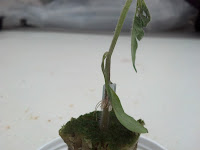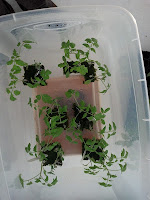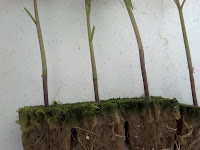An Introduction to the Process of Grafting in Greenhouse Tomatoes- Part 2

So, what comes after the graft?
In the last blog post, we went through a brief photo tour of the first two steps in the grafting process (1. Setting the Stage, and 2. Doing the Grafting). However, when discussing how to graft tomatoes at home and on the farm, it is important to know that preparation and grafting are only the first two crucial steps. Graft healing is that key third step in producing successful grafted tomatoes for your greenhouse. So, as the third blog in this series on grafting processes, I want to focus on methods of healing and the transition process from grafting to transplanting in greenhouse tomatoes.
The Healing Environment
It is important to understand that there are three crucial environmental factors involved in graft healing- humidity, light and temperature. Of course, these are the same key environmental elements that we all manage in our greenhouses, but the specific levels and ranges differ for graft healing versus production conditions. Relative Humidity- Begin around 95% immediately after grafting and reduce as healing progresses. Temperature- 80 to 84 °F is optimum Light- Begin with essentially no light for the first day or two after grafting and then gradually increase to light in the range of 500- 700 fc or around 100 µmol/m2/sec.
The Healing Chamber- Location
When carrying out grafting, there are two kinds of locations typically used by growers. The first is a chamber where conditions can be closely maintained to optimize healing. While useful for some propagation or research facilities, most growers will not have access to dedicated growth chambers and will need to use their greenhouse or attached buildings. Graft healing in greenhouses has been done for many years, and small to mid-scale temporary structures can certainly provide you with adequate healing capacity if managed well.
The Healing Chamber- Design
Most commonly, healing chambers or tents are created with clear plastic within the larger greenhouse space. In these tents, humidity can be increased and maintained with misting either by hand or with an automatic mist system. Temperature and light also need to be carefully monitored and managed. Shade cloth in different weights or layers can be used to initially exclude light and then gradually increase light during healing. Be very careful to monitor temperatures because these clear plastic tents- even shaded- can heat up quickly in a greenhouse due to solar gain. This increased temperature can in itself be high enough to damage seedlings, but it can also quickly lower the relative humidity and desiccate young grafted plants. For more northern growers seeding and grafting in early winter, greenhouse healing chambers can typically be managed adequately (as illustrated in this blog).However, if grafting tomatoes in the mid-to late spring or summer, maintaining appropriate temperatures in a tent in a greenhouse may become difficult due to ambient light and heat. Under these conditions, you may need to use your head house or some other work area fitted with a temporary chamber and lighting.
These two images show a small healing chamber constructed within a larger greenhouse (top). PVC pipe was used to construct a small tent first covered and lined with clear polyethylene plastic (4 mil construction plastic is fine) to allow a fairly tightly sealed airspace. A dome over the tray can also be used for smaller numbers of plants (bottom). Then shade cloth in one to two layers is used to cover the tent or dome.
Healing- The First Few Days
For the first day or two after grafting, near darkness is needed. This can be accomplished by covering with double or triple layers of shade cloth (depending on whether 50 or 70% shade cloth is used). Humidity is maintained with misting, but be sure to mist the plastic walls of the chamber or dome rather than the plants themselves. We want moist air to induce healing and not wet plants to encourage plant decay.
Transitioning Back to the Greenhouse
The goal of graft healing is to allow the scion and rootstock to fuse together and form new vascular connections by providing low stress conditions. Then after connections are formed, the plants is gently brought back to typical production conditions. So, humidity levels start out around 95% and after ~5 to 7 days drier air is slowly introduced to the crop by increasing venting. Likewise, light is slowly increased by removing shade and/or increasing supplemental lighting and temperature is slowly reduced. Grafted tomatoes should be ready to transition back to the greenhouse in a little under or a little over a week depending a bit on the crop and environment.
In transitioning young grafted plants back to typical greenhouse environments, conditions are slowly changed and plants are closely monitored for wilting or signs of stress. If plants show signs of stress, you can increase humidity or reduce light again for a day or two. However, keeping plants in the high humidity healing environment too long can induce roots from the scion (adventitious). These roots will hinder proper graft healing. Eventually, a ‘moment of truth’ will have to be faced. Grafts that fail to heal after 7 to 14 days are unlikely to produce high quality grafted plants due to a variety of factors including improper scion/rootstock size matching, graft technique, genetic incompatibility, or healing environment.
Newly grafted and healed plants transitioned to the greenhouse and awaiting transplant.
These are close up images of graft unions approximately eight (top) and six (bottom) days after grafting. The plants have both already been transitioned back to normal greenhouse conditions.
Remember, no one achieves 100% success...
 An unsuccessful graft (seen on the left) where the scion has produced adventitious roots to absorb water from the high humidity air in the healing chamber. As the wilted scion illustrates, these roots hinder graft healing and the plant often dies under greenhouse conditions.
An unsuccessful graft (seen on the left) where the scion has produced adventitious roots to absorb water from the high humidity air in the healing chamber. As the wilted scion illustrates, these roots hinder graft healing and the plant often dies under greenhouse conditions.
Tomatoes being transitioned after healing (ssen on the right). Some are showing slight wilting, but have adequate grafts to sustain them. A few, though, are wilted down and will not survive. Successfully grafting tomatoes is based on skill in grafting and care in healing- both of which generally improve with practice!
Planting in the Greenhouse
These two images show tomato plant graft unions approximately two weeks after grafting as they are being planted in the Bato buckets (top) and a plant growing in the bucket approximately six weeks after grafting and four weeks after transplanting (bottom).
This blog completes our introduction to grafting tomatoes in the greenhouse, but we will continue to provide updates on the growth of the plants and other facets of using grafted plants in small to mid-scale hydroponic greenhouses.
Greenhouse tomatoes hydroponics hydroponic



